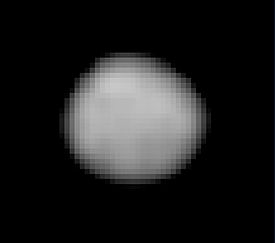2 Pallas: Perbedaan antara revisi
Tampilan
Konten dihapus Konten ditambahkan
Wagino Bot (bicara | kontrib) k →top: minor cosmetic change |
k Robot: Perubahan kosmetika |
||
| Baris 2: | Baris 2: | ||
|bgcolour=#BCD1F1 |
|bgcolour=#BCD1F1 |
||
|name=2 Pallas |
|name=2 Pallas |
||
|symbol=[[ |
|symbol=[[Berkas:Pallas symbol.svg|25px]] |
||
|physical_characteristics = yes |
|physical_characteristics = yes |
||
|image= [[ |
|image= [[Berkas:PallasHST2007.jpg|275px]] |
||
|caption= Citra ultraviolet dari Pallas yang diambil dari [[Teleskop Hubble]]. |
|caption= Citra ultraviolet dari Pallas yang diambil dari [[Teleskop Hubble]]. |
||
|discovery=yes |
|discovery=yes |
||
| Baris 21: | Baris 21: | ||
|semimajor=2,772 SA (414,737 Gm) |
|semimajor=2,772 SA (414,737 Gm) |
||
|perihelion=2,132 SA (319,005 Gm) |
|perihelion=2,132 SA (319,005 Gm) |
||
|aphelion=3,412 [[Astronomical unit|SA]] (510,468 [[Giga-| |
|aphelion=3,412 [[Astronomical unit|SA]] (510,468 [[Giga-|Gm]]) |
||
|eccentricity=0,231 |
|eccentricity=0,231 |
||
|period=4,62 [[Tahun Julian|a]] (1686,044 [[hari|hr]]) |
|period=4,62 [[Tahun Julian|a]] (1686,044 [[hari|hr]]) |
||
| Baris 67: | Baris 67: | ||
|year=2008 |
|year=2008 |
||
|bibcode = 2008CeMDA.100...27B }}</ref> |
|bibcode = 2008CeMDA.100...27B }}</ref> |
||
|density=~2,8 g/[[centi-| |
|density=~2,8 g/[[centi-|cm]]³<ref name="Hubble"/> |
||
|surface_grav=~0,18 m/s² |
|surface_grav=~0,18 m/s² |
||
|escape_velocity=~0,32 km/s |
|escape_velocity=~0,32 km/s |
||
Revisi per 21 Juli 2016 03.52
 Citra ultraviolet dari Pallas yang diambil dari Teleskop Hubble. | |
| Penemuan | |
|---|---|
| Ditemukan oleh | Heinrich Wilhelm Olbers |
| Tanggal penemuan | 28 Maret 1802 |
| Penamaan | |
| Pelafalan | [ˈpæləs] [note 1] |
Asal nama | Pallas Athena |
| Keluarga Pallas | |
| Kata sifat bahasa Inggris | Palladian[1] |
| Ciri-ciri orbit[1][3] | |
| Epos 22 Agustus 2008 (Hari Julian 2454700,5) | |
| Aphelion | 3,412 SA (510,468 Gm) |
| Perihelion | 2,132 SA (319,005 Gm) |
| 2,772 SA (414,737 Gm) | |
| Eksentrisitas | 0,231 |
| 4,62 a (1686,044 hr) | |
Kecepatan orbit rata-rata | 17,65 km/dtk |
| 306,605° | |
| Inklinasi | 34,838° ke Ekliptika 34,21° ke Bidang invariabel[2] |
| 173,134° | |
| 310,274° | |
| Elemen orbit tetap[4] | |
Sumbu semimayor tetap | 2,7709176 AU |
Eksentrisitas tetap | 0,2812580 |
Inklinasi tetap | 33,1988686° |
Pergerakan rata-rata tetap | 78.041654 ° / tahun |
Periode orbit tetap | 4.61292 tahun (1684.869 hari) |
Presesi perihelion | -1,335344 arcsec / tahun |
Presesi node menaik | −46,393342 arcsec / tahun |
| Ciri-ciri fisik | |
| Dimensi | 582×556×500±18 km[5] 544 km (rata-rata)[3] |
| Massa | (2,11±0,26)×1020 kg[6] |
Massa jenis rata-rata | ~2,8 g/cm³[5] |
| ~0,18 m/s² | |
| ~0,32 km/s | |
| 0,325 55 hari (7,8132 jam)[7] | |
| sekitar 78 ± 13°[8] | |
| Albedo | 0,159 (geometrik)[9] |
| Suhu | ~164 K maks: ~265 K (-8 °C) |
Pola spektrum | Asteroid tipe B[10] |
| 6,4[11] hingga 10,6 | |
| 4,13[9] | |
| 0,59"[12] hingga 0,17" | |
2 Pallas (pengucapan bahasa Inggris: [ˈpæləs], bahasa Yunani: Παλλάς) merupakan asteroid besar yang terletak di sabuk asteroid sistem tata surya dan merupakan asteroid ke-2 yang ditemukan. Ditemukan dan dinamai oleh astronom Heinrich Wilhelm Matthaus Olbers pada tanggal 28 Maret 1802. 2 Pallas merupakan salah satu dari 4 asteroid besar (1 Ceres, 4 Vesta, 10 Hygiea, dan 2 Pallas). Asteroid besar tersebut tak termasuk 704 Interamnia. Pallas berdiameter 530 km,[3] sedikit lebih besar dari 4 Vesta.
Referensi
- ^ OED
- ^ "The MeanPlane (Invariable plane) of the Solar System passing through the barycenter". 2009-04-03. Diarsipkan dari versi asli tanggal 2009-05-14. Diakses tanggal 2009-04-10. (produced with Solex 10 written by Aldo Vitagliano; see also Invariable plane). Retrieved 2009-04-25.
- ^ a b c "JPL Small-Body Database Browser: 2 Pallas". Diakses tanggal 2009-09-12.
- ^ "AstDyS-2 Pallas Synthetic Proper Orbital Elements". Department of Mathematics, University of Pisa, Italy. Diakses tanggal 2011-10-01.
- ^ a b Schmidt, B. E.; et al. (2008). "Hubble takes a look at Pallas: Shape, size, and surface" (PDF). 39th Lunar and Planetary Science Conference (Lunar and Planetary Science XXXIX). Held March 10–14, 2008, in League City, Texas. 1391: 2502. Diakses tanggal 2008-08-24.
- ^ Baer, James (2008). "Astrometric masses of 21 asteroids, and an integrated asteroid ephemeris" (PDF). Celestial Mechanics and Dynamical Astronomy. Springer Science+Business Media B.V. 2007. 100 (2008): 27–42. Bibcode:2008CeMDA.100...27B. doi:10.1007/s10569-007-9103-8. Diakses tanggal 2008-11-11.
- ^ Harris, A. W. (2006). "Asteroid Lightcurve Derived Data. EAR-A-5-DDR-Derived-Lightcurve-V8.0". NASA Planetary Data System. Diarsipkan dari versi asli tanggal 2007-01-28. Diakses tanggal 2007-03-15.
- ^ Torppa, J.; et al. (2003). "Shapes and rotational properties of thirty asteroids from photometric data". Icarus. 164 (2): 346–383. Bibcode:2003Icar..164..346T. doi:10.1016/S0019-1035(03)00146-5.
- ^ a b Tedesco, E. F. (2004). "IRAS Minor Planet Survey. IRAS-A-FPA-3-RDR-IMPS-V6.0". NASA Planetary Data System. Diarsipkan dari versi asli tanggal 2007-03-11. Diakses tanggal 2007-03-15.
- ^ Neese, C. (2005). "Asteroid Taxonomy. EAR-A-5-DDR-Taxonomy-V5.0". NASA Planetary Data System. Diarsipkan dari versi asli tanggal 2007-03-10. Diakses tanggal 2007-03-15.
- ^ Menzel, Donald H.; Pasachoff, Jay M. (1983). A Field Guide to the Stars and Planets (edisi ke-2nd). Boston, MA: Houghton Mifflin. hlm. 391. ISBN 0-395-34835-8.
- ^ Calculated with JPL Horizons for 2014-Feb-24
Catatan kaki
- ^ In US dictionary transcription, US dict: păl′·əs. Or as bahasa Yunani: Παλλάς.
Pranala luar
- "2 Pallas". JPL Small-Body Database Browser. Diakses tanggal 2007-03-29.
- Tedesco, Edward F.; Noah, Paul V.; Noah, Meg; Price, Stephan D. (2002). "The Supplemental IRAS Minor Planet Survey". The Astronomical Journal. 123 (2): 1056–1085. Diakses tanggal 2007-03-15.
- Hilton, James L. (1 April 1999). "U.S. Naval Observatory Ephemerides of the Largest Asteroids". U.S. Naval Observatory. Diakses tanggal 2007-03-14.
- Dunn, Tony (2006). "Ceres, Pallas Vesta and Hygeia". GravitySimulator.com. Diakses tanggal 2007-03-15.
- Yeomans, Donald K. "Horizons system". NASA JPL. Diakses tanggal 2007-03-20. — Horizons can be used to obtain a current ephemeris.
Navigasi planet minor
| ||
| Didahului oleh: 1 Ceres |
2 Pallas | Diikuti oleh: 3 Juno |

